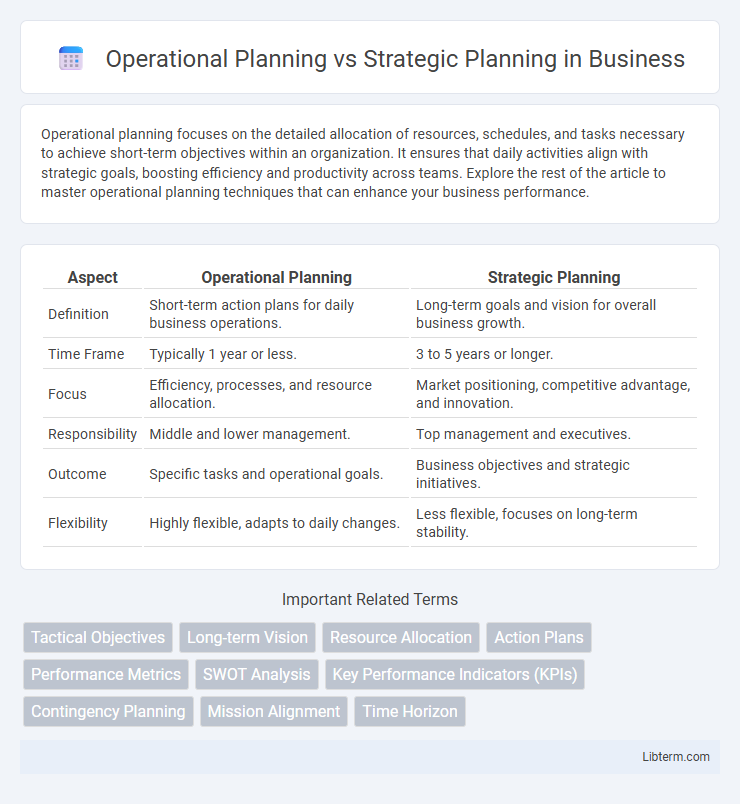Operational planning focuses on the detailed allocation of resources, schedules, and tasks necessary to achieve short-term objectives within an organization. It ensures that daily activities align with strategic goals, boosting efficiency and productivity across teams. Explore the rest of the article to master operational planning techniques that can enhance your business performance.
Table of Comparison
| Aspect | Operational Planning | Strategic Planning |
|---|---|---|
| Definition | Short-term action plans for daily business operations. | Long-term goals and vision for overall business growth. |
| Time Frame | Typically 1 year or less. | 3 to 5 years or longer. |
| Focus | Efficiency, processes, and resource allocation. | Market positioning, competitive advantage, and innovation. |
| Responsibility | Middle and lower management. | Top management and executives. |
| Outcome | Specific tasks and operational goals. | Business objectives and strategic initiatives. |
| Flexibility | Highly flexible, adapts to daily changes. | Less flexible, focuses on long-term stability. |
Introduction to Operational and Strategic Planning
Operational planning focuses on short-term actions and resource allocation to achieve specific organizational goals, emphasizing efficiency and day-to-day management. Strategic planning involves long-term vision setting, identifying overall objectives, and aligning resources to drive growth and competitive advantage over time. Both planning types are essential for organizational success, with operational plans translating strategic goals into actionable steps.
Defining Strategic Planning
Strategic planning involves setting long-term goals and determining the overall direction of an organization by analyzing internal strengths, external opportunities, and potential threats. It establishes a roadmap for achieving competitive advantage and aligns resources with the company's vision and mission. This high-level approach contrasts with operational planning, which focuses on short-term actions and day-to-day activities needed to execute the strategic objectives.
Defining Operational Planning
Operational planning focuses on outlining specific day-to-day activities, resource allocation, and timelines to achieve short-term objectives within an organization. It involves detailed task assignments, process optimizations, and performance metrics to ensure efficient execution of strategic goals. Unlike strategic planning, operational planning translates high-level strategies into actionable steps that drive immediate results and operational efficiency.
Key Differences Between Operational and Strategic Planning
Operational planning focuses on short-term actions and specific tasks required to achieve immediate business objectives, emphasizing resource allocation and process efficiency. Strategic planning involves long-term goals and overall direction, prioritizing vision, competitive positioning, and growth opportunities for sustainable success. Key differences include time horizon, scope, and the level of detail, with operational planning being tactical and focused on how to execute, while strategic planning sets the framework and defines what to achieve.
Purpose and Scope of Each Planning Type
Operational planning focuses on short-term objectives, detailing specific tasks, resource allocation, and timelines to ensure daily activities align with broader goals. Strategic planning encompasses long-term vision, setting overarching goals and determining the direction for growth, competitive advantage, and market positioning. The purpose of operational planning is to implement the strategic plan through actionable steps, while strategic planning defines the overall mission and priorities guiding organizational success.
Timeframes: Short-Term vs Long-Term Focus
Operational planning centers on short-term objectives, typically spanning days to months, designed to manage day-to-day activities and immediate resource allocation. Strategic planning emphasizes long-term goals, often extending over several years, guiding overall organizational direction and growth. The distinct timeframes allow operational planning to implement specific tasks efficiently, while strategic planning sets broad priorities and future vision.
Stakeholders Involved in Planning Processes
Operational planning primarily involves middle managers, team leaders, and frontline employees who focus on short-term objectives and day-to-day activities. Strategic planning engages senior executives, board members, and key external stakeholders like investors and partners to establish long-term goals and organizational direction. Effective planning processes require coordination among these stakeholders to align operational tasks with strategic priorities, ensuring cohesive execution across all organizational levels.
Tools and Techniques for Effective Planning
Operational planning utilizes tools such as Gantt charts, workflow diagrams, and resource allocation matrices to manage day-to-day activities and ensure efficient execution of tasks. Strategic planning employs SWOT analysis, balanced scorecards, and PESTEL analysis to evaluate long-term objectives, competitive positioning, and external environmental factors. Combining these tools enhances alignment between immediate operational goals and overarching strategic vision, promoting coherent and adaptive organizational growth.
Common Challenges in Operational and Strategic Planning
Operational planning and strategic planning both face common challenges such as aligning resources with goals, managing uncertainties, and ensuring effective communication across teams. Balancing short-term operational demands with long-term strategic objectives often results in conflicts that hinder decision-making. Inadequate data analysis and resistance to change further complicate the execution of both operational and strategic plans.
Integrating Operational and Strategic Plans for Success
Integrating operational and strategic plans ensures alignment between long-term goals and day-to-day activities, enhancing organizational efficiency and effectiveness. Operational planning translates strategic objectives into actionable tasks with clear timelines and resource allocations, enabling progress tracking and adaptability. Effective integration fosters communication across departments, driving cohesive decision-making and sustainable success.
Operational Planning Infographic

 libterm.com
libterm.com